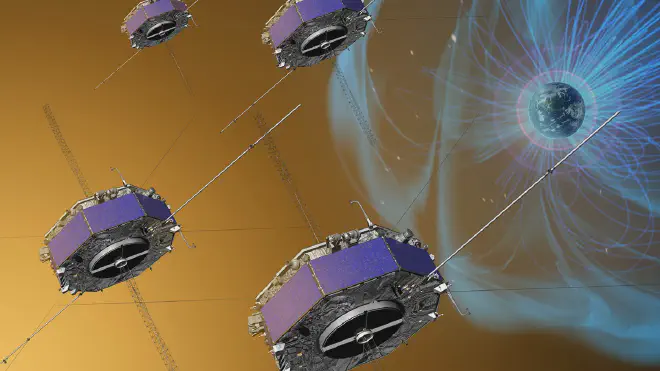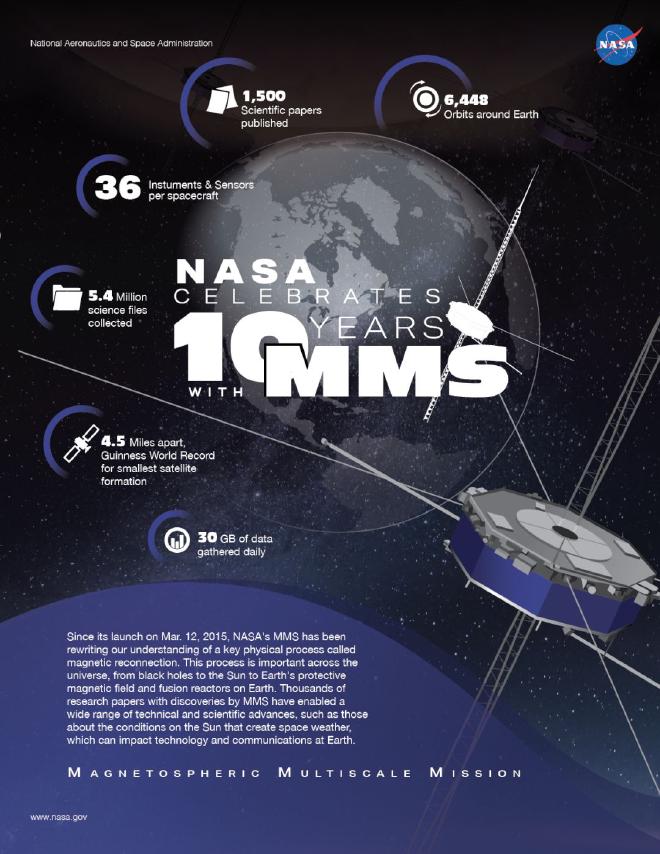

Sarah Stanley signed in EOS an article about magnetic reconnection published in Geophysical Research Letters. There she explains that in magnetic reconnection, adjacent magnetic field lines break and snap together to form new lines. This process converts magnetic energy to both thermal energy, or heat, and kinetic energy, or the acceleration of particles, creating jets of electrons and ions. Magnetic reconnection plays a key role in many outer space events such as solar flares and aurorae, as well as in laboratory methods related to nuclear fusion.
Several years ago, observations of Earth’s magnetic field by NASA’s Magnetospheric Multiscale mission led to the discovery that magnetic reconnection can occur with only electron jets, without also involving the acceleration of ions. These events also have a relatively high reconnection rate, meaning the involved magnetic field lines snap together quickly. Now Fan et al. report the results of new simulations that deepen the understanding of these electron-only events.
The researchers applied a computational method known as particle-in-cell simulation to model the behavior of ions and electrons during magnetic reconnection. They ran 12 simulations to explore what factors might underlie electron-only reconnection.
The team also realized that magnetic reconnection and field line bending may not develop at the same pace. A relatively thin initial current sheet allows the reconnection rate to peak before field lines are fully bent, leading to calculations of high reconnection rates if they are normalized by ion parameters. However, the calculations of the reconnection rate are more typical when they are normalized by electron parameters.
These findings could help clarify the fundamental physics of magnetic reconnection, the authors suggest. (Geophysical Research Letters, https://doi.org/10.1029/2024GL113889, 2025)
—Sarah Stanley, Science Writer
Citation: Stanley, S. (2025), New insights into an enigmatic form of magnetic reconnection, Eos, 106, https://doi.org/10.1029/2025EO250138. Published on 11 April 2025. Authors: Cheng-Yu Fan, Shan Wang, Xu-Zhi Zhou, San Lu, Quanming Lu, Prayash Sharma Pyakurel, Qiugang Zong, Zhi-Yang Liu
Text © 2025. AGU. CC BY-NC-ND 3.0
Except where otherwise noted, images are subject to copyright. Any reuse without express permission from the copyright owner is prohibited.
Funding #
The study is supported by National Natural Science Foundation of China Grant 42374188. The simulation work was carried out at National Supercomputer Center in Tianjin, China, and the calculations were performed on TianHe-HPC.
About Magnetospheric Multiscale mission #
MMS was launched on March 12, 2015. Observe and measure how the Sun’s and Earth’s magnetic fields connect and disconnect, explosively transferring energy from one to the other. This process occurs throughout the universe and is known as magnetic reconnection.
Why is this so important? #
Around Earth, a single magnetic reconnection event can release as much energy in a couple of hours as the entire United States uses in a day.
Over the past 10 years wrote Mara Johnson-Gro, thousands of research papers with discoveries by MMS have enabled a wide range of technical and scientific advances, such as those about the conditions on the Sun that create space weather, which can impact technology and communications at Earth. It has also enabled insights for fusion energy technologies.
“The MMS mission has been a very important asset in NASA’s heliophysics fleet observatory,” said Guan Le, MMS mission lead at NASA’s Goddard Space Flight Center in Greenbelt, Maryland. “It has utterly changed how we understand magnetic reconnection.”

“The MMS mission not only studies universal physical processes, but it also allows us to probe the mechanisms that connect big eruptions on the Sun to things we experience on Earth, such as auroras, geomagnetic storms, and even power outages in extreme cases,” said Kevin Genestreti, MMS science deputy principal investigator and lead scientist at Southwest Research Institute’s Space Sector in Durham, New Hampshire.
The Perfect Laboratory #
Using four identical spacecraft, MMS studies magnetic reconnection while traveling in a long, oval-shaped orbit around Earth — a perfect laboratory for closely studying magnetic reconnection.
“You can measure reconnection in a laboratory, but the scales are so very small there that you can’t make the detailed measurements needed to really understand reconnection,” said Jim Burch, principal investigator for MMS at the Southwest Research Institute in San Antonio, Texas.
Where? #
Magnetic reconnection primarily happens in two locations around Earth, one located on the side facing the Sun, and another behind Earth farther away from the Sun. In their orbit, the four MMS spacecraft repeatedly pass through these key locations.
Before MMS, scientists only had a limited understanding of magnetic reconnection. But by improving instrument measurement speeds tenfold, MMS has been able to dramatically reshape what we know about the process. To date, MMS data has led to over 1,500 published scientific articles.
“For example, it turned out that the basic theory of reconnection in turbulent regions was wrong because previous missions couldn’t make observations at the level MMS can,” Burch said. “We also found reconnection in a lot of places that weren’t predicted.”
“One of the truly groundbreaking findings from MMS is that the heart of reconnection has a well-ordered beat – even if everything around is turbulent,” said Michael Hesse, MMS theory and modeling lead at NASA’s Ames Research Center in California’s Silicon Valley. “This shows that precision measurement can decide between competing theories.”
Enabling Breakthroughs for Science and Scientists #
The mission’s successes have also been a boon to young scientists, who are closely involved with the mission at all levels.
“In addition to its scientific achievements, it has also helped almost 50 students get doctorate degrees and enabled early career scientists to grow into leadership positions,” Le said.
To foster young scientists, MMS provides early career research grants to team members. The MMS team also created “Leads In-Training” roles to bring early career scientists to the table for big mission decisions and provide them the experience they need to move into leadership positions. The program has been so successful it is now required for all NASA Heliophysics missions.
Breaking Records #
Beyond its scientific achievements, MMS also holds several records. Only months after launch, MMS received its first Guinness World Record for highest GPS fix at 44,000 miles above Earth. It would later shatter this record as it moved into a longer orbit, taking it 116,300 miles — halfway to the Moon — away from GPS transponders at Earth. GPS is designed to send signals down toward Earth, so using it in space, where signals are weak, is challenging. By using GPS at high altitudes, MMS has shown its potential for other applications.
“This GPS demonstration has been of great interest for the developers of the Artemis missions, which is testing GPS at lunar distances,” said Jim Clapsadle, MMS mission director at NASA Goddard.
The mission also holds the Guinness World Record for smallest satellite formation, with just 2.6 miles between spacecraft. Over the years, MMS’ four spacecraft have flown in lines and pyramid-shaped formations from 5 to 100 miles across to help scientists study magnetic reconnection on a range of scales. In that time, the spacecraft’s health has remained remarkably well.
“The hardware has proved very reliable, even now, 10 years into flight,” said Trevor Williams, MMS flight dynamics lead at NASA Goddard*.
After launch, Williams and the flight operations team came up with more fuel-efficient ways to maneuver the spacecraft and keep them at their designated separations. As a result, the mission still has about a fourth of the fuel it launched with. This economy leaves enough fuel to continue operating the mission for decades. That’s good news to mission scientists who are eager to continue studying magnetic reconnection with MMS.
“We have thousands of magnetic reconnection events on the day side, but far fewer on the nightside,” Burch said. “But over the next three years we’ll be in a prime location to finish investigating nightside reconnection.”

